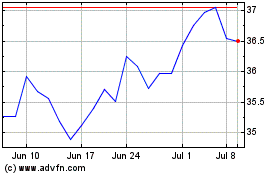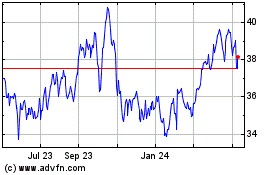Shell, BP Earnings Benefit From Cost Cuts Amid Weak Oil Prices -- Update
November 01 2016 - 10:42AM
Dow Jones News
By Sarah Kent and Selina Williams
LONDON-- Royal Dutch Shell PLC and BP PLC posted
better-than-expected third-quarter profits, joining other big oil
companies in showing progress in efforts to adapt to a world of
cheaper crude as prices rebounded from lows hit at the start of the
year.
The European companies' results underlined a sense of cautious
optimism creeping into the oil industry after over two years of
falling profits or losses in a sector once known as a reliable cash
machine. BP and Shell both said they see oil supply and demand
coming back into balance after being glutted long enough to sink
prices by over 50%.
Both companies also said they had made progress with efforts to
stabilize profits even during a third quarter when prices averaged
less than $46 a barrel.
"2015 and 2016 was about restoring balance," said BP Chief
Financial Officer Brian Gilvary on a call with analysts.
Shell returned to profit, posting the equivalent of $1.4 billion
net income in the third quarter of 2016, after reporting a net loss
of $6.1 billion a year earlier. BP's net earnings of $1.7 billion
were up from $1.2 billion a year earlier.
BP and Shell's results were a positive signal in a mixed season
of earnings. French oil giant Total SA last week said its
third-quarter profit almost doubled from a year earlier to nearly
$2 billion, a gain the company's chief executive, Patrick Pouyanne,
attributed to deep cost cuts.
In the U.S., Chevron Corp. returned to the black after recording
losses for three straight quarters, aided by self-help measures to
cut spending and costs, though its earnings were still down 35%
compared with the third quarter of 2015.
Exxon Mobil Corp., the world's largest publicly traded oil
producer, registered its eighth straight quarter of year-over-year
profit decline, illustrating how the efforts to manage the price
downturn are still a work in progress.
Oil prices were generally lower in the third quarter of 2016
compared with the same time in 2015, averaging $45.86 a barrel for
Brent crude, the international benchmark. The prices are down over
50% from the heights of $100 a barrel or more they traded at for
much of 2011 to 2014. A global oversupply of oil has kept the
market depressed.
Most big oil companies are continuing to work to bring down
their costs in an uncertain price environment. Shell said next year
it expects to spend $25 billion on finding and developing new oil
and gas projects, at the lower end of a spending range it disclosed
this year to investors. BP said it planned capital spending in 2016
of $16 billion, down from the $17 billion to $19 billion previously
forecast. Exxon slashed its capital and exploration spending 45% in
the third quarter from a year earlier.
Shell and BP's results were important landmarks for both
companies after a tumultuous few years. For Shell, the sharp
increase in profits marked a victory for management, demonstrating
for the first time the value the company's massive acquisition of
BG Group earlier this year could bring.
BP's results were the first unmarked by significant charges
related to the company's fatal blowout in the Gulf of Mexico in
2010. The company is trying to move on from the accident after
putting a final cost on the disaster of $61.6 billion over the
summer.
Any recovery could still be on a knife edge as members of the
Organization of the Petroleum Exporting Countries are struggling to
hammer out a final plan for a modest output cut before a Nov. 30
meeting in Vienna. Their failure to agree is keeping a lid on oil
prices that staged a modest recovery last month and optimism within
the industry remains cautious.
There are signs executives are more willing to consider new
investments.
BP is looking at advancing two new big oil and gas developments
this year, taking the total number approved in 2016 to five, Mr.
Gilvary said.
Shell is more circumspect. Chief Financial Officer Simon Henry
said Tuesday that large new project approvals are "not top of my
list of priorities at the moment."
"We're planning next year on $50 a barrel. We're planning the
balance sheet for potentially even lower than that, and we're
building the portfolio to be robust at anything above $50 a
barrel," he said.
Write to Sarah Kent at sarah.kent@wsj.com and Selina Williams at
selina.williams@wsj.com
(END) Dow Jones Newswires
November 01, 2016 10:27 ET (14:27 GMT)
Copyright (c) 2016 Dow Jones & Company, Inc.
BP (NYSE:BP)
Historical Stock Chart
From Mar 2024 to Apr 2024

BP (NYSE:BP)
Historical Stock Chart
From Apr 2023 to Apr 2024
